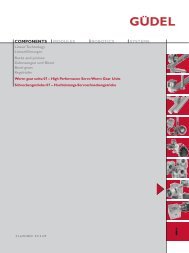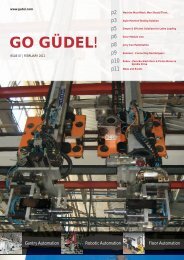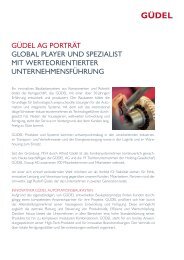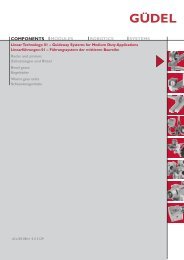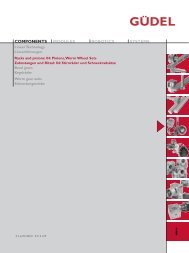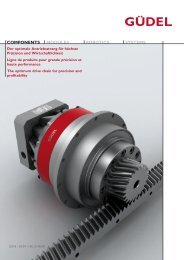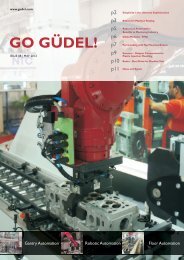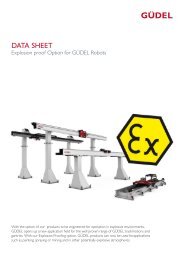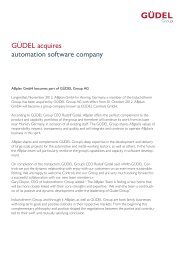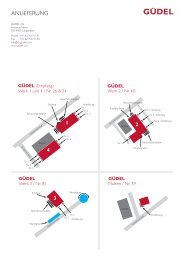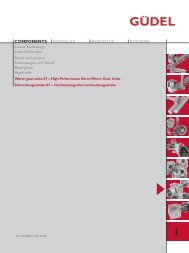stirnräder aus stahl - Güdel
stirnräder aus stahl - Güdel
stirnräder aus stahl - Güdel
Create successful ePaper yourself
Turn your PDF publications into a flip-book with our unique Google optimized e-Paper software.
STIRNRÄDER<br />
ROUES DENTÉES<br />
PINIONS<br />
Wichtige Hinweise Informations importantes Important notes<br />
Die angegebenen Drehmomente (Md) Werte<br />
basieren auf einer mittleren Drehzahl von<br />
200 U/min bei<br />
Les valeurs de couple indiquées sont basées<br />
sur une valeur de 200tr/min avec:<br />
The listed torques (Md) are based on a rotation<br />
speed of 200 rpm<br />
s F = 1.4<br />
(Sicherheitsfaktor Zahnfussbeanspruchung)<br />
s H = 1.0<br />
(Sicherheitsfaktor Zahnflankenbeanspruchung)<br />
Für höhere Leistungen empfehlen wir ein<br />
nachträgliches Nitrieren (Bad-, Gas-, Plasma-)<br />
mit Faktor 1.5 oder ein Induktivhärten der<br />
Zähne mit Faktor 2.5.<br />
Für hohe Leistungen und Drehzahlen wird der<br />
Einsatz der gehärteten und ballig geschliffenen<br />
oder schälwälzgefrästen Zahnräder in Qualität<br />
6 (ab Seite 03.08/03.13/03.27) empfohlen.<br />
Für besondere Anwendungen mit hohen<br />
Notlaufeigenschaften und Geräuschdämpfung,<br />
grosser Verschleissfestigkeit und Dimensionsstabilität<br />
sind die LMV-PA12G Kunststoffzahnräder<br />
mit eingegossenen Stahlnaben<br />
geeignet (ab Seite 04.15).<br />
Für einfache Antriebe genügen oft unsere<br />
<strong>aus</strong> dem Kunststoff Hostaform C gespritzten<br />
Zahnräder, wobei unsere Berechnungsgrundlagen<br />
Ihnen einen schnellen Hinweis<br />
auf die geeigneten Elemente geben.<br />
Nacharbeiten nach Ihren Zeichnungen stellen<br />
für uns kein Problem dar, ebenso wie komplette<br />
Sonderanfertigungen in nahezu allen<br />
Werkstoffen in den Dimensionsbereichen<br />
unserer Standardelemente.<br />
Die angegebenen Drehmomente (Md) beziehen<br />
sich auf eine Paarung von zwei Stirnrädern des<br />
jeweiligen Typs.<br />
s F = 1.4<br />
(Coefficient de sécurité pour la contrainte de<br />
flexion)<br />
s H = 1.0<br />
(Coefficient de sécurité pour la pression superficielle)<br />
en fonctionnement continu<br />
Pour des charges plus élevées nous recommandons<br />
de traiter les roues par trempage superficielle<br />
qui donne une élévation de couple de<br />
env. 2.5 ou par nitratation qui donne une élévation<br />
de couple de env. 1.5.<br />
Pour de hautes puissances et de hautes vitesses<br />
de rotation nous recommandons de travailler<br />
avec des pignons avec denture trempée et rectifiée<br />
bombée ou fraisée en qualité 6 (dès page<br />
03.08/03.13/03.27).<br />
Pour des applications spéciales avec pauvre<br />
lubrification, silencieux et grande stabilité des<br />
dimensions nous proposons des pignons en plastic<br />
type LMV-PA12G avec des moyeux moulés<br />
insolubles (dès page 04.15).<br />
Pour des applications inférieures il suffit de choisir<br />
des pignons fait par injection en Hostaform<br />
C ou nos calculs vous aident de choisir très<br />
rationnel le pignon correspondant à votre<br />
utilisation.<br />
Nous pouvons également réaliser des roues<br />
selon plan, et cela dans la plupart des matières<br />
selon les dimensions de nos éléments<br />
standard.<br />
Les couples notées (Md) se rapportent à une<br />
combinaison de deux roues du type correspondant.<br />
s F = 1.4<br />
(Safety factor for tooth root stress)<br />
s H = 1.0<br />
(Safety factor for Hertzian stress)<br />
for continious operation<br />
For higher performance we recommend nitrating<br />
(factor 1.5) or to harden (factor 2.5)<br />
the teeth.<br />
For high performance and high torque applications<br />
we recommend you fit hardened and crowned<br />
pinions in tooth quality of 6 (page<br />
03.08/03.13/03.27).<br />
For special applications with poor lubrication,<br />
low noise, low wear and high dimensional<br />
stability we have plastic pinions and plastic<br />
pinions in LMV PA12G with a cast metal insert.<br />
(page 04.15).<br />
For less accurate applications it might be suitable<br />
to choose moulded pinions made of<br />
Hostaform C where our calculation input helps<br />
to choose the correct elements.<br />
We are able to offer our standard pinions<br />
machined to suit your requirements.<br />
The mentioned torques (Md) refer to a combination<br />
of two pinions of the corresponding<br />
type.<br />
04.03



